Manzoor Ali Shah
The 2008 edition of Pakistan’s famous Shandur Polo festival starts today. It will continue for three days. This polo tournament, organized by Gilgit and Chitral polo clubs, will be played at Shandur Pass which is considered as the the highest Polo Ground in the World.
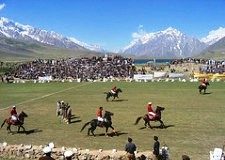
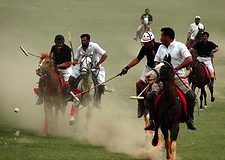
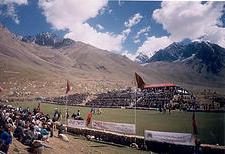
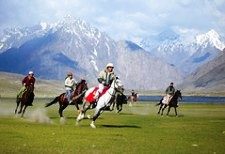
The game of polo has been played for a long time in the world, but in Pakistan it sometimes assumes mythical importance
Pakistan’s northern areas are famous for their natural beauty. They have awe-inspiring mountains, serene lakes, roaring rivers and gigantic glaciers. But the game of polo attracts many a visitor to the region for reasons other than watching nature’s munificence.
Polo is one of the oldest games played in the world. And the northern areas are known for the kind of polo played here. Every year, in the second week of July, polo teams from Chitral and Gilgit face each other in Shandur — the world’s highest polo ground. This event dates back to old colonial times when in the ‘30s a British political agent, Maj Evelyn Cobb, who was fond of playing the game in the moonlit Shandur, initiated polo matches in the area.
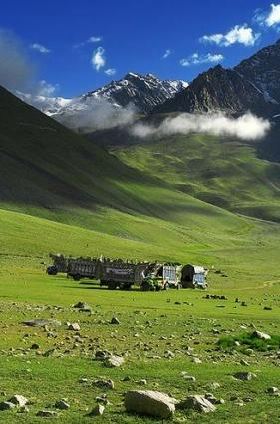 The photo on the right shows Shandur valley. This photo is courtesy of Kamran Safdar at flickr.com
The photo on the right shows Shandur valley. This photo is courtesy of Kamran Safdar at flickr.com
The Shandur pass is situated about 3,738 metres above sea level and lies between Gilgit and Chitral. It is 147 km from Chitral and 211 km from Gilgit. In the winter, it remains frozen due to the heavy snowfall that engulfs everything beneath its white blanket. At the end of the spring season, this area — a plateau among the Hidukush Mountains — becomes a lush green land. And the greenery with galloping horses, the zealous spectators and the tent city in the high Hidukush underneath the open skies in the background of the Shandur Lake, present a magical view.
As Shandur has a mythical importance in Chitrali folklore, it is said that it is the abode of the fairies (Shhawanan), and at night these fairies come down to the lake and splash its water.
Nowadays, open air cultural festivities, including dance shows and concerts, are held here during nighttime as part of polo matches in which maestros from Gilgit and Chitral enthral the audiences with their performances. And during daytime, polo matches catch the public’s attention.
An international polo match is divided into six chukkers (circles), each is seven-and-a-half-minute long. And an umpire, riding a horse, monitors the game. Usually, one team consists of three or four players. The polo played in the northern areas is different in many respects from international polo. Here, the game is divided into two stints of 25 minutes each with a break of 10 minutes between them. Unlike international polo, one cannot change one’s horse — only if the horse receives serious injuries. Rules are few and there is no referee or umpire. The only official is a time-keeper. There are 12 players, six from each team. A player can hit his opponent with his mallet, give him a push, and run over his opponent’s horse. And the 12 players pursue the ball in such a frantic manner that it leaves spectators in awe. Generally, a swollen face, a bandaged head or a limping horse shows that the match was interesting enough.
Polo originated in Persia in 500BC. Polo is basically a Balti word, meaning ball. In Persian it is known as “Chowganâ€. Initially, polo was played as part of the training of imperial cavalry guards. From Persia, polo spread into far-flung lands like China, Japan, Egypt, and Byzantine and became a royal pastime. Even in the subcontinent, it is said that Sultan Qatubudin Abik died after falling off a pony while he was playing polo. In China, the death of a court favourite during a polo match in 910 made the king order the beheading of all players. In the 13th century, polo was in vogue in Central Asia after being introduced there by Muslim conquerors. From Central Asia, perhaps, it made inroads into the northern areas of Pakistan.
Chitral, Gilgit, and the northern areas are the places where polo is played in its age-old style. How much the people of these region love this game can be judged from the fact that in the northern areas in the heart of each village and locality we find a polo ground. It is obviously a sacrifice keeping in view the scarcity of land. As in the case of Chitral, 70 per cent of the population lives below the poverty line and earns less than Rs 5,000 a month. Their lavish spending on polo shows that these poor people consider this game something mythical.
When a polo match starts, local musicians play traditional tunes. When a goal is scored, the player who has scored it gallops towards the centre line holding the ball in his right hand, and on reaching the centre line tosses the ball into the air and hits it with his mallet while in the background musicians play a special tune for him. This is called Thompq in Chitral.
A version of this article also appeared in Dawn of July 30, 2006.



















































Shandur festival is the only event in the northern areas which never stopped itself from taking place due to recent terrorism wave. Events like this give us hope that Pakistan is still a country where people love the fun and sports/cultural activities. May Allah bless Pakistan and may this event passes peacefully this time of year as well.
Dear Amina & fouzia,
I’ve recently visited Gilgit and adjacent areas (Mar 09). These places are really beautiful and worth watching. The people are very hospitable and there is no issue of being unsafe there.
I really appreciate ur gesture about Pakistan Amina. I feel the same in Gilgit but i must told you ppl are not separate from us. u are a part of us. Gilgit is as important as Karachi is. I can show you several important cities and sites which are in the mainstream but no development has been done so far from last 60 years. Actually we have scarcity of true leaders. Current leaders are looking for their benefits not people benefits.
Pak Army is the true picture of unity. No one is Balti, Punjabi, Pashtun etc. in Pak Army. They are Pakistani i.e why Balti shed their blood in Kargil and the others are shedding their blood in Siachin.
I hope you will understand all such things. So be Pakistani, Proud Pakistani. That is the ladder for success.
Your well wisher.
i wish to go Shandoor.. i love Skerdu..realy.. ahh..realy want to go there..